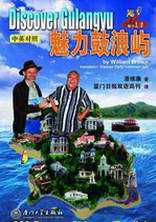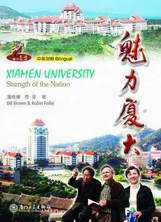![]() Click
to
Access
Click
to
Access
OUTSIDE China
![]() Click
to Access
Click
to Access
INSIDE
China ![]()
TRAVEL LINKS
![]() Xiamen
Xiamen
![]() Gulangyu
Gulangyu
![]() Jimei
Jimei
![]() Tong'an
Tong'an
![]() Jinmen
Jinmen
![]() Zhangzhou
Zhangzhou
![]() Quanzhou
Quanzhou
![]() Wuyi
Wuyi
![]() #1Fujian
Sites!
#1Fujian
Sites!
![]() Fujian
Foto Album
Fujian
Foto Album
![]() Books
on Fujian
Books
on Fujian
![]() Readers'Letters
Readers'Letters
![]() Ningde
Ningde
![]() Zhouning
Zhouning
![]() Longyan
Longyan
![]() Sanming
Sanming
![]() Putian
Putian
![]() Bridges
Bridges
![]() Travel
Info,
Travel
Info,
![]() Hakka
Roundhouses
Hakka
Roundhouses
![]() Travel
Agents
Travel
Agents
MISC. LINKS
![]() Amoy
People!
Amoy
People! ![]()
![]() Darwin
Driving
Darwin
Driving ![]()
![]() Amoy
Tigers
Amoy
Tigers
![]() Chinese
Inventions
Chinese
Inventions
![]() Tibet
in 80 Days!
Tibet
in 80 Days!![]()
![]() Dethroned!
Dethroned!
![]()
![]() Misc.Writings
Misc.Writings
![]() Latest
News
Latest
News
![]() Lord
of Opium
Lord
of Opium
![]() Back
to Main Page
Back
to Main Page
![]() Order
Books
Order
Books![]() Xiamenguide
Forum
Xiamenguide
Forum 

Discover
Gulangyu! 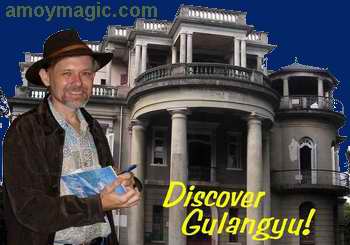 In
Xiamen bookstores or Order
Online.
In
Xiamen bookstores or Order
Online.
Gulangyu--Isle
of Music, Arts & Literature (excerpts)
![]() Main
Page
Main
Page ![]() ÖÐÎÄ
ÖÐÎÄ
![]() "Music
as Life in China"
"Music
as Life in China" ![]() "The
Sounds of Music"
"The
Sounds of Music" ![]() "Xiamen
Music Academy"
"Xiamen
Music Academy" ![]() "Zheng
Xiaoying--Favorite Daughter"
"Zheng
Xiaoying--Favorite Daughter" ![]() "Gulangyu's
First Family of Music"
"Gulangyu's
First Family of Music" ![]() "Conductor
Zuohuang Chen"
"Conductor
Zuohuang Chen" ![]() "Xiamen
Gulangyu Piano Museum"
"Xiamen
Gulangyu Piano Museum" ![]() "Gulangyu
Organ Museum"
"Gulangyu
Organ Museum" ![]() "Teng
Hiok Chiu--Rediscovered Artist!"
"Teng
Hiok Chiu--Rediscovered Artist!" ![]() "Lin
Yutang--an International Chinese Writer"
"Lin
Yutang--an International Chinese Writer" ![]() ÖÐÎÄ
ÖÐÎÄ
![]() "Lin
Yutang Photo Album"
"Lin
Yutang Photo Album"
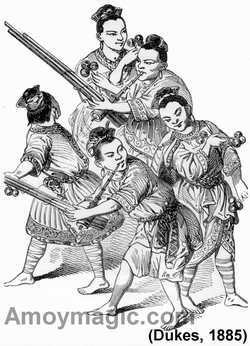
Music as Life in China
from "A Race of Green Ginger," by Anne Averil-McKenzies (Gulangyu
resident in the 20s and 30s)
“In China, music had been inextricably woven into the whole pattern
of life. The notes of its pentatonic scale were male and female, were
each related to the compass, the planets, the elements; to substances
and colors…Music not only had the powers that the West knew through
Orpheus, but was held by the Chinese to be essential to the world's equilibrium.
Through his musical harmonies or disharmonies, man was responsible for
the balance of the earth. The welfare of the empire depended on the correctness
of the pitches and scales that he made. But it was in man’s heart
that music was born, and ‘it is the heart that works the miracles,
the great heart that in music finds its voice and form.’ Music,
the ancient Chinese believed, affected government and government affected
music. Fourteen centuries before Christ, the psychological and therapeutic
value of music was not only recognized but accepted as part of the apparatus
of rule, as it was later in classical Greece. The Emperor Wu who lived
in the first century B.C. created an imperial office of Music, with special
departments for the composition of the various kinds necessary, not to
entertainment, but to ritual and to rule.”
Anne-Averil McKenzie, “A Race of Green Ginger,” 1920s
 Back
to top
Back
to top
The
Sounds of Music Gulangyu folk have been
hooked on pianos ever since missionaries arrived with Bibles in one hand
and pianos in the other (very big hands!).
China’s “Piano Islet” now has more pianos per capita
than anywhere else in China, as well as Asia’s largest piano museum
and what will soon be the world’s largest organ museum.
Gulangyu’s dozens of famous pianists and musicians have included
Zhou Shuan in the ‘20s, Lin Junqing in the ‘30s, Wu Tianqiu
in the ‘50s, and Xu Feixing in the 60s. Gulangyu is also the hometown
of acclaimed conductor Chen Zuohuang, and Yin Chengzong, whom the New
York Times has deemed the best Chinese pianist on the planet. In the 80s,
Mr. Xu Feiping, a postgraduate student of the Juilliard School of Music,
won many international prizes, including the Gold Medal in the 4th Arthur
Rubinstein International Piano Master Competition in 1983 in Israel. And
Gulangyu is still churning out globally acclaimed prodigies, thank to
the Xiamen Music Academy.
Back to top
Xiamen
Music Academy (Xiamen Yinyue Xuexiao),
founded in 1988, has a staff of over 100 experienced teachers and professors
teaching over 500 students of keyboards, strings, wind instruments, Chinese
instruments, and vocals.
The school has fruitful exchange programs with schools and organizations
in Australia, Japan, America, Germany, Russia, Malaysia, and Singapore,
and has recruited prodigies from throughout the world. One of the school’s
first students, Miss Yao Lan is typical of Gulangyu’s newest talents.
Yao Lan moved with her parents from neighboring Jiangxi Province to Xiamen
and, intrigued by the home’s large piano, began lessons at age four.
She won first prize in a children’s piano competition at age ten
and was accepted into a primary school attached to Beijing’s Central
Conservatory of Music. She received a scholarship for the Royal Academy
of Music in London and during graduate and postgraduate studies won several
competitions in Britain. A Polish company produced an album of her performance
in the 14th International Chopin Piano Competition.
After Yao Lan gave a performance in Xiamen in 2004, she said she hopes
to eventually 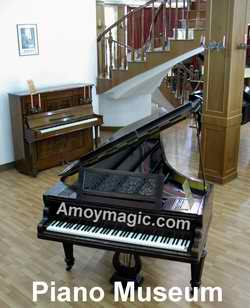 settle
down on the island that today, more than ever, deserves the name “Isle
of Music.”
settle
down on the island that today, more than ever, deserves the name “Isle
of Music.”
Back to top
Xiamen
Gulangyu Piano Museum Given Gulangyu’s
musical heritage, it is no surprise that Australian Overseas Chinese Mr.
Hu Youyi chose his ancestral home for Asia’s largest piano museum,
which has over 70 pianos from the U.K., France, U.S., Germany, Australia,
and Austria, and over 100 priceless piano lamps.
The Gulangyu Piano Museum’s two halls are set within the tropical
flowers and trees of a 2,000 square meter tract of land on the hill overlooking
Shuzhuang Garden and the sea.
A perfect way to finish the museum tour is to sit
on one of the piano benches before the ceiling-to-floor plate glass windows
and savor the scenery while listening to piped in classical piano pieces.
Mr. Hu’s collection includes a French street musician's barrel piano
(I half expected to see an organ grinder and a monkey), the Broadwood
& Sons piano that won a golden medal at the Paris International Fair,
a grand piano with ivory keys from an English palace, and a piano cherished
by president Lincoln.
Back to top
The first of the two halls, opened January of 2000, has the collection’s
oldest piano. Few pianos were actually built by pianists, but this instrument
was crafted in 1801 by visionary composer Muzio Clementi (1752-1832).
Clementi crafted both uprights and grands on which to perform his more
than 106 sonatas (46 were for violin, cello or flute), as well as countless
smaller pieces. Clementi is also remembered for the horrifying tale in
which George Grove visited Clementi’s nephew, a vicar in south-east
England, and found the maid lighting a fire with Clementi’s manuscript!
I wonder if she was fired?
Hall #1 also has the world’s tallest upright piano (an 1824 Broadwood
& Sons, from London), and Hall No. 2 showcases the development of
the piano with exhibits like the 1928 Haines. The most expensive piano
of its era, this American marvel was completely automatic, able to perfectly
imitate the styles of many well known pianists. As of this writing, the
Haines is played for visitors daily at 4 pm. Address: No.45 Huangyan Rd
(Shuzhuang Garden)
Gulangyu Organ Museum The only such museum in China and soon to be the largest of its kind in the world, it opened in early 2005 in the red-domed Bagua Building with exhibits donated by the Piano Museum’s founder, Mr. Hu Youyi. Vivian Zhang quoted Hu as saying at the museum’s opening concert,
“Pipe organs are acclaimed as the most sublime and divine musical instrument in the west. I hope one day organ lovers from all over the world will come on a music pilgrimage to my hometown, Gulangyu, to appreciate its beauty.”
Back to top
The organ played at the opening concert was a historic
“Norman & Beard” made in 1909. The 6 meter high instrument
has 1,350 pipes, 3 layers of keyboards and 21 organ stops, and took Ian
Wakeley, an Australian organ technician, over a month to restore and tune.
Ian explained why the organ  was
in such good shape:
was
in such good shape:
“It is made of the best materials by the best builders with the best techniques and is representative of the highest level at that time. And that is why, after nearly a century, it still remains in amazingly good condition while most other instruments of its age have long since decayed.”
This organ was formerly in England’s Cradley Heath
Methodist Church, where Paul Carr
[Click Here to visit his website]
gave his 100th and final concert on it in June 2003. Carr seems happy
with its new home. He wrote, “as the organ will not be squashed
into a corner, as it was at Cradley Heath, it could sound up to 50% louder!”
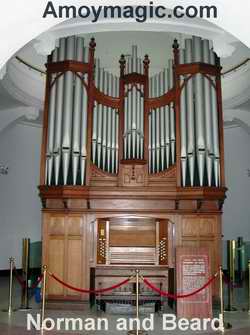
The church was to be closed, so organist Mark Checkley spread the word
on the internet that the venerable instrument needed a home, but after
18 months and 250 responses, the best offer was from a local organ builder
who wanted to dismantle the beauty and salvage pipes and parts for a future
organ. But finally they heard that Ian Wakeley was seeking an organ for
a Chinese client, and within a couple of weeks the organ was destined
for Gulangyu.
The day after the church’s final service on Sunday, July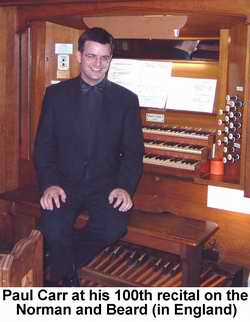 18th, Ian and two assistants began 4 days of carefully dismantling the
instrument and packing the components into crates custom made on the spot.
Organist Paul Carr said it took four men six hours just to load the parts
onto the truck, where it was hauled to Southhampton Dock, loaded onto
the slow boat to China—and reassembled on Gulangyu.
18th, Ian and two assistants began 4 days of carefully dismantling the
instrument and packing the components into crates custom made on the spot.
Organist Paul Carr said it took four men six hours just to load the parts
onto the truck, where it was hauled to Southhampton Dock, loaded onto
the slow boat to China—and reassembled on Gulangyu.
Visit this remarkable instrument—and ask the attendants to play
it for you!
Click Here to visit organist
Paul Carr's Website
Click Here to e-mail Paul Carr
Back to top
Zheng
Xiaoying-- the Isle of Music’s Favorite Daughter
The brightest star today in Gulangyu’s firmament of musical talent
is Madame Zheng Xiaoying, who according to Western media is “the
best woman conductor in the world.” Madame Zheng has performed at
home and throughout Hong Kong, Taiwan and Macao, as well as in Russia,
Japan, Australia, the U.S., Italy, Finland, Singapore, France, Holland,
Germany, the U.K., Sweden, Estonia and Thailand.
Madame Zheng is the first Chinese musician to make popularizing the symphony
her lifelong goal, and she has given over 2,000 performances with lectures
to an estimated 300,000 people in mainland China.
Back to top
In a concert just days before her 75th birthday Madame Zheng still exemplified
the exuberance that helped generations of her Hakka forebears succeed
in China and abroad. And like all traditional Hakka, she values education,
and uses her “Zheng Xiaoying System” to teach not only musicians
but audiences to better understand and enjoy symphony. And as she learned
early on in Xiamen, audiences do indeed need that education.
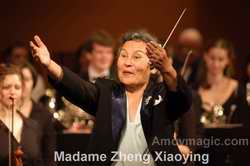 Before
Madame Zheng was invited to Xiamen in 1998 to create China’s first
international model professional orchestra, Xiamen’s symphony orchestra
performances were lucky to get a couple dozen attendees a week. But with
funding from local enterprises, Madame Zheng left her position as chief
conductor of China’s Central Opera Theater and Dean of the Department
of Conducting at China’s Central Conservatory of Music to create
the Xiamen Philharmonic Orchestra. It was a blind leap of faith, but in
just 6 short years her 30-member orchestra has grown to over 80 members,
and has made a name for itself both in China and abroad. As of this writing,
the Xiamen Philharmonic has given over 450 performances with a repertoire
of over 100 symphonies and symphonic suites, 100 concertos for various
instruments, and over 200 overtures, symphonic poems and other pieces.
Before
Madame Zheng was invited to Xiamen in 1998 to create China’s first
international model professional orchestra, Xiamen’s symphony orchestra
performances were lucky to get a couple dozen attendees a week. But with
funding from local enterprises, Madame Zheng left her position as chief
conductor of China’s Central Opera Theater and Dean of the Department
of Conducting at China’s Central Conservatory of Music to create
the Xiamen Philharmonic Orchestra. It was a blind leap of faith, but in
just 6 short years her 30-member orchestra has grown to over 80 members,
and has made a name for itself both in China and abroad. As of this writing,
the Xiamen Philharmonic has given over 450 performances with a repertoire
of over 100 symphonies and symphonic suites, 100 concertos for various
instruments, and over 200 overtures, symphonic poems and other pieces.
Madame Zheng was the first nationally recognized female conductor in China,
and the first Chinese conductor to take the podium of an opera theater
abroad or to conduct a foreign opera company. She took advanced studies
at the National Conservatory of Music in Moscow, where she received the
French Literature and Arts Medal of Honor. Madame Zheng founded the Women’s
Philharmonic Orchestra (Ai Yue Nu, ), which became China’s first
women’s chamber and symphony orchestra, and in 1995 in Beijing,
she conducted both the orchestra and the chorus as they performed Beethoven’s
“Ode to Joy” for the opening of the United Nations 4th World
Conference on Women.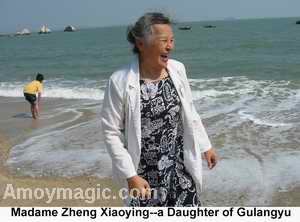
Back to top
On November 23, 2002, in Middletown, Connecticut, Madame Zheng conducted
the Wesleyan University Orchestra in “Echo of Hakka Earthen Buildings”.
She was accompanied by the symphony’s composer, Liu Yuan, and two
famous Fujian folk musicians—mountain vocalist Li Tiansheng (“King
of W. Fujian Mountain Songs”) and Qiu Shaochun, the famous Fujian
“leaf player,” who blew the audience away with music produced
with nothing more than a natural leaf (I wonder how often he has to turn
over a new leaf?).
The Wesleyan orchestra spent half a year preparing, but Madame Zheng had
only one week for on-site rehearsals, and the chorus rehearsed the finale,
“A Song of Hakka (in Hakka dialect, no less!) only once, for one
hour. The performance still earned a standing ovation, and Madame Zheng
returned home, happy she had helped forge another link between East and
West by teaching Americans about China, and helping Chinese better appreciate
symphony.
A music student wrote of the Wesleyan concert, “Mixing a Western-looking
orchestra with Asian feel was very emotional and thought-provoking, especially
because it involved aspects of Europe, Asia and America.” Another
student said, “The music evoked a sense of awe and pride.”
While Madame Zheng has had a busy professional life she has always kept
her family as a high priority—and music appears to run in her family
even as it has the Yin’s for the past seven decades. Her daughter
Su Zheng is a highly regarded ethnomusicologist.
Back to top
Gulangyu’s
First Family of Music—the Yin’s
The Yin family, led by its banker patriarch, arrived
on Gulangyu in the ‘30s and settled easily into the world of privilege
that the International Settlement afforded foreigners and wealthy Chinese.
The Yins were Christians, and since all Gulangyu churches had at least
one piano, they quickly took to music, producing decades of talented musicians
and vocalists. A female soprano made Christian recordings in the 1930s,
and a male Yin became a famous baritone and settled in Los Angeles in
the 1980s. Yin Chengdian is a music teacher and founder of the Xia-men
Music School. But the most famous member of the family is Yin Chengzong,
whom the New York Times has said is “China’s best pianist”,
with an “absolutely beautiful command of piano color.”
Yin was born on Gulangyu in 1941 and began piano at age 7—virtually
self-taught. He gave his first recital at age 9, and at 12 enrolled in
the Shanghai Conservatory of Music. At 18 he won a gold medal in the piano
competition of the World Youth Peace and Friendship Festival in Vienna.
He enjoyed qu`ite a reputation—until the Cultural Revolution’s
Red Guards denounced all things Western, including philosophy, literature,
and music—and those who indulged in such decadence. The savvy Yin
rolled a piano into Tiananmen Square and for three days played revolutionary
tributes to Chairman Mao, saving not only his own hide but also his prized
bourgeois instrument. This, perhaps more than anything else, not only
stopped Red Guards from beating pianists and violinists but also moved
China to adopt these instruments for the revolutionary cause.
Back to top
Mr. Yin helped write the revolutionary “Yellow River Concerto,”
which is popular even today, but after the Cultural Revolution he was
again persecuted and banned from playing for several years.
Yin Chengzong moved to the U.S. in 1983, settled down in Manhattan, and
put politics, but not China, behind him. In 2003, Chengzong made a concert
tour of China, and now plans to help Gulangyu’s renovation of architecture
and emphasis of its musical heritage. Visit the Yin’s Villa at #16
Jishan Rd.
Conductor
Zuohuang Chen The world famous conductor Zuohuang
Chen was born in 1947 in Shanghai but grew up on Gulangyu Islet—so
we claim him. Chen graduated from the Central Conservatory of Music’s
middle school in 1965—just in time to be sent to the countryside
during the Cultural Revolution. Western literature and music were banned,
so he toiled in fields by day and by night furtively studied music he’d
smuggled from Beijing.
Chen received his conducting degree in 1981, and took a master’s
class with Seiji Ozawa, music director of the Boston Symphony Orchestra.
He then studied in the U.S. at the Tanglewood Music Center and the University
of Michigan’s School of Music. In 1985, at the University of Michigan,
he became the first Chinese to earn a Doctor of Musical Arts. In 1986,
during two years of directing the University of Kansas Symphony Orchestra,
he received the HOPE award for outstanding teaching.
Back to top
In 1987, Chen became conductor of the Central Philharmonic Society in
Beijing, and after touring 24 U.S. cities he led this orchestra, as well
as the China Youth Symphony Orchestra and the China Junior Symphony Orchestra,
on six highly successful tours of European and Asian countries.
Chen was music director and conductor for the Wichita Symphony Orchestra
from 1990 to 2000, conductor of the Rhode Island Philharmonic Orchestra
from 1991 to 1996, and received the Art Award and a Citation from the
governors of both Kansas and Rhode Island.
In 1996, Chen became the first artistic director and principal conductor
of the China National Symphony Orchestra—China’s first professional
orchestra to adopt a contract system and professional management of performances.
Chen has visited over 20 countries as guest conductor for 30 orchestras,
including the Mexico National Symphony Orchestra, Colorado Symphony Orchestra,
Zurich Tonhalle Orchestra, Vancouver Symphony Orchestra, Hungary State
Symphony Orchestra, Pacific Symphony Orchestra, Hamburg Youth Symphony
Orchestra of Germany, Russia Philharmonic Orchestra, Slovak Radio Symphony
Orchestra, Haifa Symphony Orchestra of Israel, Hong Kong Philharmonic
Orchestra, and the Taipei City Symphony Orchestra.
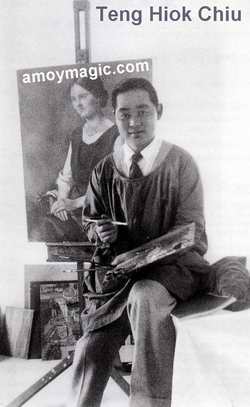 Back
to top
Back
to top
Teng Hiok Chiu—Gulangyu’s
Rediscovered Artist Gulangyu’s main
claim to fame is music but recently we’ve learned the islet has
also produced at least one internationally acclaimed artist!
Teng Hiok Chiu (Zhou Tingxu, 1903-1972) was born on Gulangyu into a family
of wealthy tea merchants.
Chiu’s youth was a time of political turmoil, but the beauty of
Gulangyu opened his eyes to art. He wrote,
“Since I used to play amidst the beautiful temples and pine trees
or on the sandy beach, I have wanted to appreciate the best in nature
and to be able to help everyone else to do so.”
At age 14 Chiu was sent to the London Missionary Society’s
Anglo-Chinese College in Tianjin. After graduating he moved to the U.S.
in 1920, studied art history, architecture and archaeology in Harvard
for a semester, and then moved on to the Museum School of Fine Arts in
Boston. He went to Paris in 1923, and in 1925 won a royal family-funded
scholarship for the Royal Academy of Arts. Over the next five years, Chiu
won every art competition he entered. (He was also a member of Britain’s
Olympic basketball team!)
Back to top
But Chiu never courted fame, and after his death in 1972 the once celebrated
artist’s masterpieces were sold 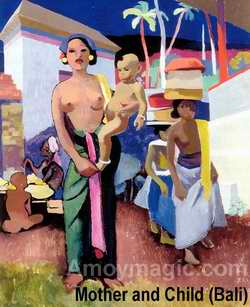 off
at auctions and even garage sales, his paintings in China were destroyed
by Red Guards, and the world forgot him. I was fortunate enough to learn
about Chiu only because Xiamen University’s Professor Tang Shaoyun
gave me Rose Tang’s article, “Bold Comeback,” which
recounted Dr. Kazimierz Z. Poznanski’s rediscovery of Chiu when
he came across 4 small black and white photos of Chiu’s paintings
in an auction catalogue.
off
at auctions and even garage sales, his paintings in China were destroyed
by Red Guards, and the world forgot him. I was fortunate enough to learn
about Chiu only because Xiamen University’s Professor Tang Shaoyun
gave me Rose Tang’s article, “Bold Comeback,” which
recounted Dr. Kazimierz Z. Poznanski’s rediscovery of Chiu when
he came across 4 small black and white photos of Chiu’s paintings
in an auction catalogue.
Like many foreigners, Dr. Kaz cared little for classical Chinese paintings,
and thought modern Chinese art was just a poor imitation of Western Art.
He told Common Talk’s Vivian Zhang, “But in the West, people
don’t give much attention to Chinese oil painters, assuming that
Chinese artists using western techniques are just imitating instead of
creating original art.” But Dr. Kaz was captivated by the beauty
and harmony—the innate “Chineseness”—of Chiu’s
Western-style oils, which he says rivals or even surpasses the best of
Cezanne and Gauguin.
Dr. Kaz collected over 70 of Chiu’s paintings, as well as all of
the documents, letters and photos he could find, and has studied Taoist
philosophy to enhance his appreciation not only of Chiu’s works
but of Chinese art as a whole. He has even taken up Chinese-style watercolor
painting on rice paper in his own attempt to marry elements of both Chinese
tradition and Western technique.
Back to top
Dr. Kaz appreciates Chiu’s middle of the road approach, avoiding
both imitation of classic Chinese and mindless copying of modern Western
art. Professor Tang Shaoyun told Rose Tang, 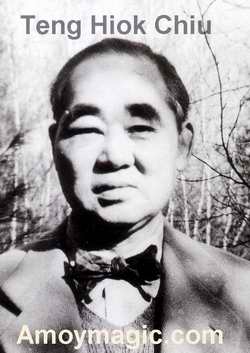
“[Chiu] was a typical Chinese artist, who was depicting
the elegance and tranquility of an ideal world where humans are in harmony
with nature. He was in constant dialogue with nature. He painted his calm
and relaxed mood…. He was in his own fantasy world. He painted for
himself. Supported by a rich family and scholarships, he didn’t
have to make a living by painting. One can tell from his pictures that
he had little interest in wealth or fame.
“…This is why he was so rare. He kept his style by refusing
to follow trends when even Picasso had to keep changing his styles to
stay on top. Today China is full of avant garde artists who chase Western
trends to grab attention.”
In 2004, over 50,000 people attended Dr. Kaz’s 3-month
exhibition of Chiu’s works in Seattle’s Fye Art Museum. The
record-breaking attendance for that museum suggested that many Americans
would like to know more about Chinese art, artists, and culture. If Dr.
Kaz’ succeeds in opening his Gulangyu museum for Chiu’s works,
we too will have a chance to better appreciate this almost forgotten artist.
Back to top
![]() Favorite
Fujian Sites
Favorite
Fujian Sites ![]() Fujian
Foto Album
Fujian
Foto Album ![]() Xiamen
Xiamen
![]() Gulangyu
Gulangyu
![]() Fujian
Guides
Fujian
Guides ![]() Quanzhou
Quanzhou
![]() Zhangzhou
Zhangzhou
![]() Longyan
Longyan
![]() Wuyi
Mtn
Wuyi
Mtn ![]() Ningde
Ningde
![]() Putian
Putian
![]() Sanming
Sanming
![]() Zhouning
Zhouning
![]() Taimu
Mtn.
Taimu
Mtn. ![]() Roundhouses
Roundhouses
![]() Bridges
Bridges
![]() Jiangxi
Jiangxi
![]() Guilin
Guilin
![]() Order
Books
Order
Books
![]() Readers'
Letters
Readers'
Letters
Last Updated: May 2007
![]()
DAILY
LINKS
![]() FAQs
Questions?
FAQs
Questions?
![]() Real
Estate
Real
Estate
![]() Shopping
Shopping
![]() Maps
Maps
![]() Bookstores
Bookstores
![]() Trains
Trains
![]() Busses
Busses
![]() Car
Rental
Car
Rental
![]() Hotels
Hotels
![]() News
(CT)
News
(CT)
![]() Medical
& Dental
Medical
& Dental
![]() YMCA
Volunteer!
YMCA
Volunteer! ![]()
![]() XICF
Fellowship
XICF
Fellowship
![]() Churches
Churches
![]()
![]() Expat
Groups
Expat
Groups
![]() Maids
Maids
![]() Phone
#s
Phone
#s
EDUCATION
![]() Xiamen
University
Xiamen
University
![]() XIS(Int'l
School)
XIS(Int'l
School)
![]() Study
Mandarin
Study
Mandarin
![]() CSP(China
Studies)
CSP(China
Studies)
![]() Library
Library
![]() Museums
Museums
![]() History
History
DINING
![]() Restaurants
Restaurants
![]() Asian
Asian
![]() Veggie
Veggie
![]() Junk
Food
Junk
Food
![]() Chinese
Chinese
![]() Italian
Italian
![]() International
International![]()
![]() Visas
4 aliens
Visas
4 aliens
RECREATION
![]() Massage!
Massage!
![]() Beaches
Beaches
![]() Fly
Kites
Fly
Kites
![]() Sports
Sports
![]() Boardwalk
Boardwalk
![]() Parks
Parks
![]() Pets
Pets
![]() Birdwatching
Birdwatching
![]() Kung
Fu
Kung
Fu ![]() Hiking
Hiking
![]() Music
Events
Music
Events
![]() Festival&Culture
Festival&Culture
![]() Humor&
Humor&![]() Fun
Fotos
Fun
Fotos![]()
BUSINESS
![]() Doing
Business
Doing
Business
![]() Jobs!(teach/work)
Jobs!(teach/work)
![]() Hire
Workers
Hire
Workers
![]() Foreign
Companies
Foreign
Companies
![]() CIFIT
(Trade Fair)
CIFIT
(Trade Fair)
![]() MTS(Translation)
MTS(Translation)
![]()
Back to Top
